Utilisation of Ceramic Stoneware Tile Waste as Recycled Aggregate in Concrete
Abstract
1. Introduction
2. Materials and Methods
2.1. Aggregates Characterisation
2.2. Concrete Design and Sample Preparation
2.3. Fresh and Hardened Concrete Characterisation
3. Results and Discussion
3.1. Fresh Concrete Workability
3.2. Compressive and Tensile Strength of the hardened Concrete
3.3. Water Penetration of the Hardened Concrete
3.4. Visual Appearance of Aggregates Distribution
4. Conclusions
- –
- The particle size distribution of the CS and natural gravel were similar. The greater hardness of the recycled CS aggregates led to a larger particle size and a more discontinuous distribution in the CS sand compared to natural sand.
- –
- Workability generally improved in RACs, especially in those prepared by replacing natural gravel with CSCA.
- –
- Strength results were comparable to those presented by conventional concrete. Compressive strength of CSFA concretes slightly reduced and was maintained or improved in those prepared with CSCA. The minor variations in the tensile strength values, no matter what the type (CSFA, CSCA) or CW content, were attributed to concrete heterogeneity.
- –
- The water penetration depths of RACs generally reduced and, although they increased in the CSFA100 sample, this concrete could be used in any exposure class except the most aggressive environments.
- –
- The workability, strength and water penetration of the CSFA concrete could be improved by further crushing these aggregates and correcting particle size distribution. However, the additional required energy would reduce sustainability.
- –
- Future studies that simultaneously replace natural sand and gravel with the CS recycled particles would further improve the sustainability of the developed RACs.
Author Contributions
Funding
Data Availability Statement
Acknowledgments
Conflicts of Interest
List of Abbreviations
References
- Zhao, X.; Hwang, B.G.; Lim, J. Job Satisfaction of Project Managers in Green Construction Projects: Constituents, Barriers, and Improvement Strategies. J. Clean. Prod. 2020, 246, 118968. [Google Scholar] [CrossRef]
- Aïtcin, P.C. Cements of Yesterday and Today: Concrete of Tomorrow. Cem. Concr. Res. 2000, 30, 1349–1359. [Google Scholar] [CrossRef]
- Miller, S.A.; Moore, F.C. Climate and Health Damages from Global Concrete Production. Nat. Clim. Change 2020, 10, 439–443. [Google Scholar] [CrossRef]
- United Nations Environment Programme. Sand and Sustainability: Finding New Solutions for Environmental Governance of Global Sand Resources; United Nations Environment Programme: Geneva, Switzerland, 2019; Available online: https://wedocs.unep.org/handle/20.500.11822/28163;jsessionid=558EDAD4BA96501D192543683DB10CA4 (accessed on 27 July 2023).
- Struble, L.; Godfrey, J. How Sustainable Is Concrete? In Proceedings of the International Workshop on Sustainable Development and Concrete Technology, Beijing, China, 20–21 May 2004.
- Samadi, M.; Huseien, G.F.; Mohammadhosseini, H.; Lee, H.S.; Abdul Shukor Lim, N.H.; Tahir, M.M.; Alyousef, R. Waste Ceramic as Low Cost and Eco-Friendly Materials in the Production of Sustainable Mortars. J. Clean. Prod. 2020, 266, 121825. [Google Scholar] [CrossRef]
- Usmani, M.U.; Muthusamy, K. Potential of Waste Material as Coarse Aggregates for Lightweight Concrete Production: A Sustainable Approach. Construction 2023, 3, 87–114. [Google Scholar] [CrossRef]
- Baraldi, L. World Production and Consumption of Ceramic Tiles. Ceram. World 2021, 41, 26–40. [Google Scholar]
- European Environment Agency. Construction and Demolition Waste: Challenges and Opportunities in a Circular Economy; Publications Office of the European Union: Luxembourg, 2019. [Google Scholar] [CrossRef]
- Ministerio de Transportes Movilidad y Agenda Urbana RD470/2021—Código Estructural; 2021. Available online: https://www.mitma.gob.es/organos-colegiados/comision-permanente-de-estructuras-de-acero/cpa/codigo-estructural (accessed on 27 July 2023).
- Bommisetty, J.; Keertan, T.S.; Ravitheja, A.; Mahendra, K. Effect of Waste Ceramic Tiles as a Partial Replacement of Aggregates in Concrete. Mater. Today Proc. 2019, 19, 875–877. [Google Scholar] [CrossRef]
- Goyal, R.K.; Agarwal, V.; Gupta, R.; Rathore, K.; Somani, P. Optimum Utilization of Ceramic Tile Waste for Enhancing Concrete Properties. Mater. Today Proc. 2021, 49, 1769–1775. [Google Scholar] [CrossRef]
- Rashid, K.; Razzaq, A.; Ahmad, M.; Rashid, T.; Tariq, S. Experimental and Analytical Selection of Sustainable Recycled Concrete with Ceramic Waste Aggregate. Constr. Build. Mater. 2017, 154, 829–840. [Google Scholar] [CrossRef]
- Sivakumar, A.; Srividhya, S.; Sathiyamoorthy, V.; Seenivasan, M.; Subbarayan, M.R. Impact of Waste Ceramic Tiles as Partial Replacement of Fine and Coarse Aggregate in Concrete. Mater. Today Proc. 2022, 61, 224–231. [Google Scholar] [CrossRef]
- Mas, M.A.; Monzó, J.; Payá, J.; Reig, L.; Borrachero, M.V. Ceramic Tiles Waste as Replacement Material in Portland Cement. Adv. Cem. Res. 2016, 28, 221–232. [Google Scholar] [CrossRef]
- Pitarch, A.M.; Reig, L.; Tomás, A.E.; Forcada, G.; Soriano, L.; Borrachero, M.V.; Payá, J.; Monzó, J.M. Pozzolanic Activity of Tiles, Bricks and Ceramic Sanitary-Ware in Eco-Friendly Portland Blended Cements. J. Clean. Prod. 2021, 279, 123713. [Google Scholar] [CrossRef]
- Pereira-de-Oliveira, L.A.; Castro-Gomes, J.P.; Santos, P.M.S. The Potential Pozzolanic Activity of Glass and Red-Clay Ceramic Waste as Cement Mortars Components. Constr. Build. Mater. 2012, 31, 197–203. [Google Scholar] [CrossRef]
- Asensio de Lucas, E.; Medina, C.; Frías, M.; Sánchez de Rojas, M.I. Clay-Based Construction and Demolition Waste as a Pozzolanic Addition in Blended Cements. Effect on Sulfate Resistance. Constr. Build. Mater. 2016, 127, 950–958. [Google Scholar] [CrossRef]
- Barreto, E.d.S.; Stafanato, K.V.; Marvila, M.T.; de Azevedo, A.R.G.; Ali, M.; Pereira, R.M.L.; Monteiro, S.N. Clay Ceramic Waste as Pozzolan Constituent in Cement for Structural Concrete. Materials 2021, 14, 2917. [Google Scholar] [CrossRef] [PubMed]
- UNE 933-1 Standard; Tests for Geometrical Properties of Aggregates—Part 1: Determination of Particle Size Distribution—Sieving Method. Asociación Española de Normalización y Certificación (AENOR): Madrid, Spain, 2012.
- UNE 1097-6 Standard; Tests for Mechanical and Physical Properties of Aggregates—Part 6: Determination of Particle Density and Water Absorption. Asociación Española de Normalización y Certificación (AENOR): Madrid, Spain, 2014.
- Medina-Martínez, C.; Sáez del Bosque, I.F.; de Lucas, E.A.; Caneda-Martínez, L.; Rojas, M.F.; de Rojas Gómez, M.I.S. Recycled Ceramics in Concrete. In Encyclopedia of Renewable and Sustainable Materials; Elsevier: Amsterdam, The Netherlands, 2020; pp. 483–489. [Google Scholar] [CrossRef]
- Da Silva, A.L.; Feltrin, J.; Dal Bó, M.; Bernardin, A.M.; Hotza, D. Effect of Reduction of Thickness on Microstructure and Properties of Porcelain Stoneware Tiles. Ceram. Int. 2014, 40, 14693–14699. [Google Scholar] [CrossRef]
- ISO 13006 Standard; Ceramic Tiles—Definitions, Classification, Characteristics and Marking. ISO: Geneva, Switzerland, 2018.
- UNE-EN 14411 Standard; Ceramic tiles—Definition, Classification, Characteristics, Assessment and Verification of Constancy of Performance and Marking. Asociación Española de Normalización y Certificación (AENOR): Madrid, Spain, 2016.
- Instituto Valenciano de la Edificación. Guía de la Baldosa Cerámica; Instituto Valenciano de la Edificación: Valencia, Spain, 2019. [Google Scholar]
- Zanelli, C.; Raimondo, M.; Guarini, G.; Dondi, M. The Vitreous Phase of Porcelain Stoneware: Composition, Evolution during Sintering and Physical Properties. J. Non-Cryst. Solids 2011, 357, 3251–3260. [Google Scholar] [CrossRef]
- TA Instruments. Volume Changes in Porcelain Bodies during the Cooling Phase after Firing. Available online: https://www.tainstruments.com/pdf/literature/DIL002.pdf (accessed on 27 July 2023).
- UNE-EN 197-1 Standard; Cement—Part 1: Composition, Specifications and Conformity Criteria for Common Cements. Asociación Española de Normalización y Certificación (AENOR): Madrid, Spain, 2011.
- UNE-EN 12350-2 Standard; Testing fresh concrete—Part 2: Slump Test. Asociación Española de Normalización y Certificación (AENOR): Madrid, Spain, 2020.
- UNE-EN 12390-3 Standard; Testing Hardened Concrete—Part 3: Compressive Strength of Test Specimens. Asociación Española de Normalización y Certificación (AENOR): Madrid, Spain, 2020.
- UNE-EN 12390-6 Standard; Testing Hardened Concrete—Part 6: Tensile Splitting Strength of Test Specimens. Asociación Española de Normalización y Certificación (AENOR): Madrid, Spain, 2010.
- UNE-EN 12390-8 Standard; Testing Hardened Concrete—Part 8: Depth of Penetration of Water under Pressure. Asociación Española de Normalización y Certificación (AENOR): Madrid, Spain, 2020.



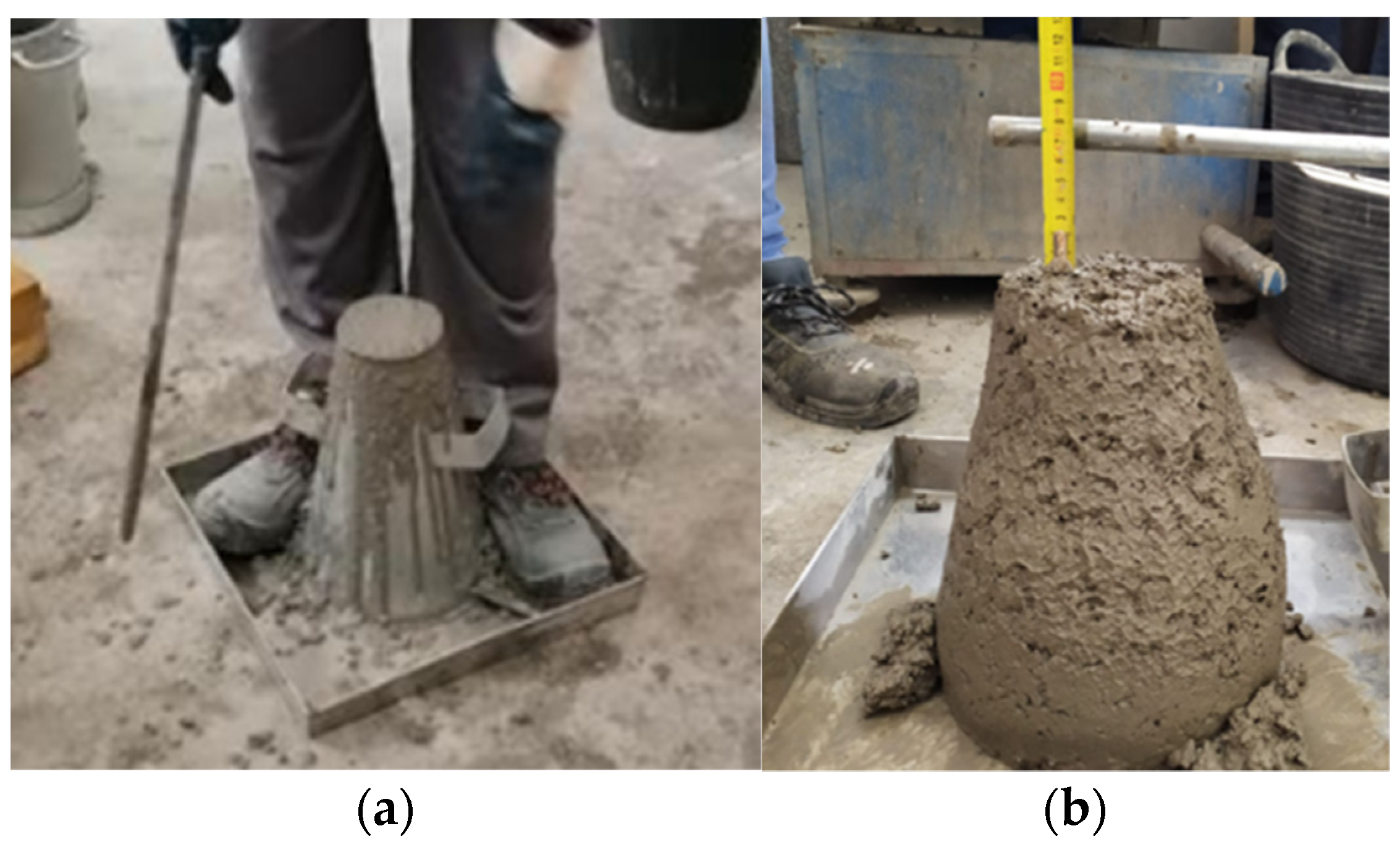
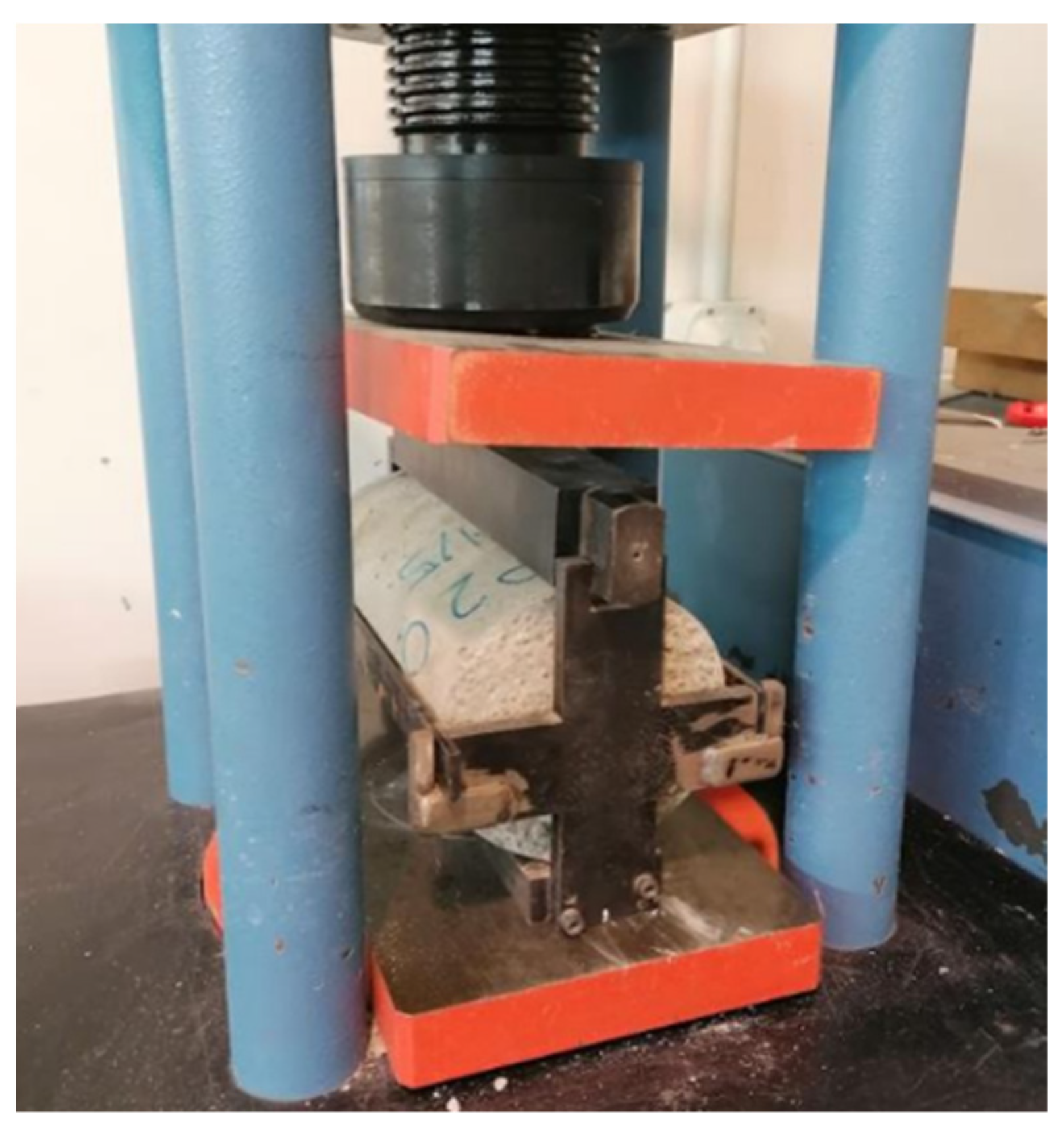
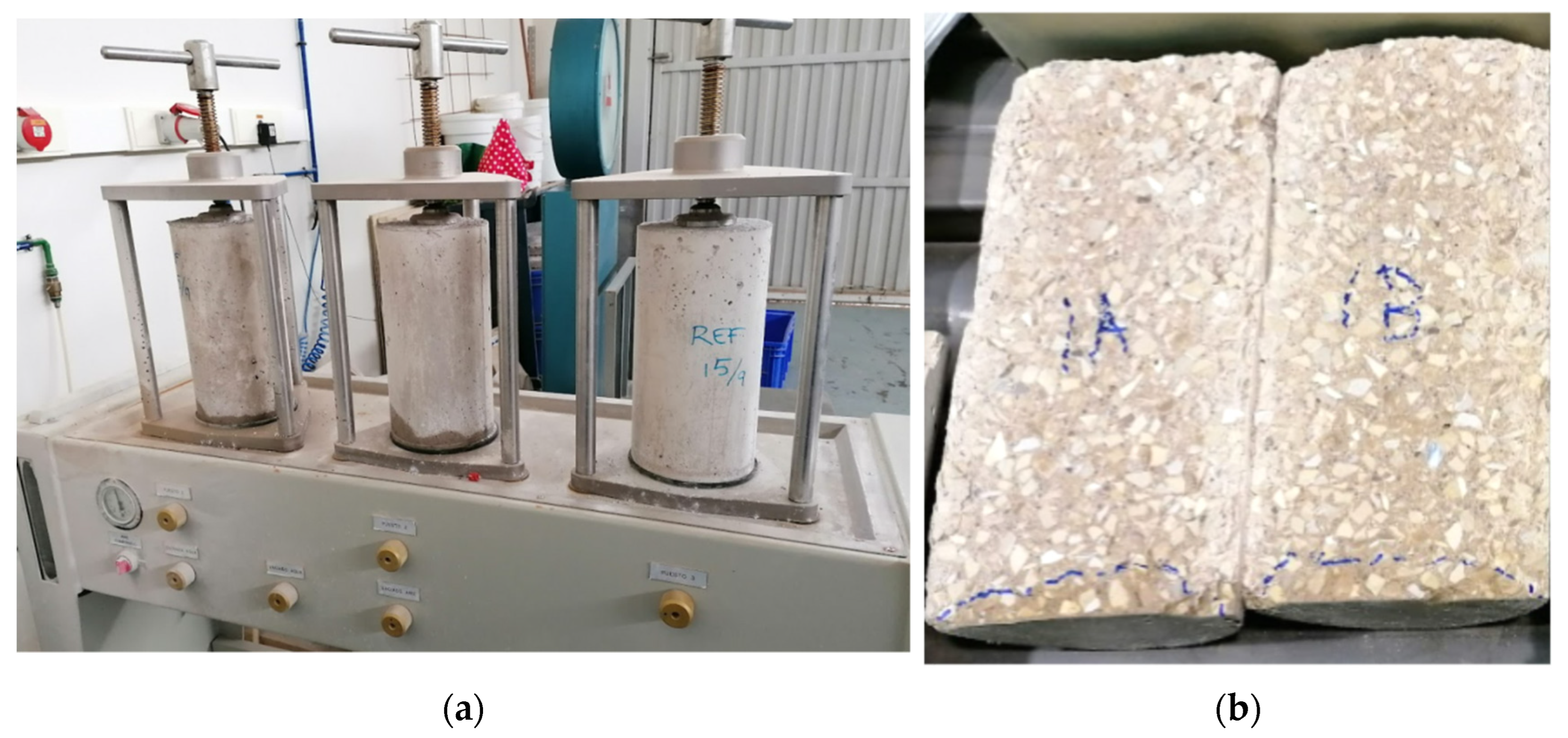


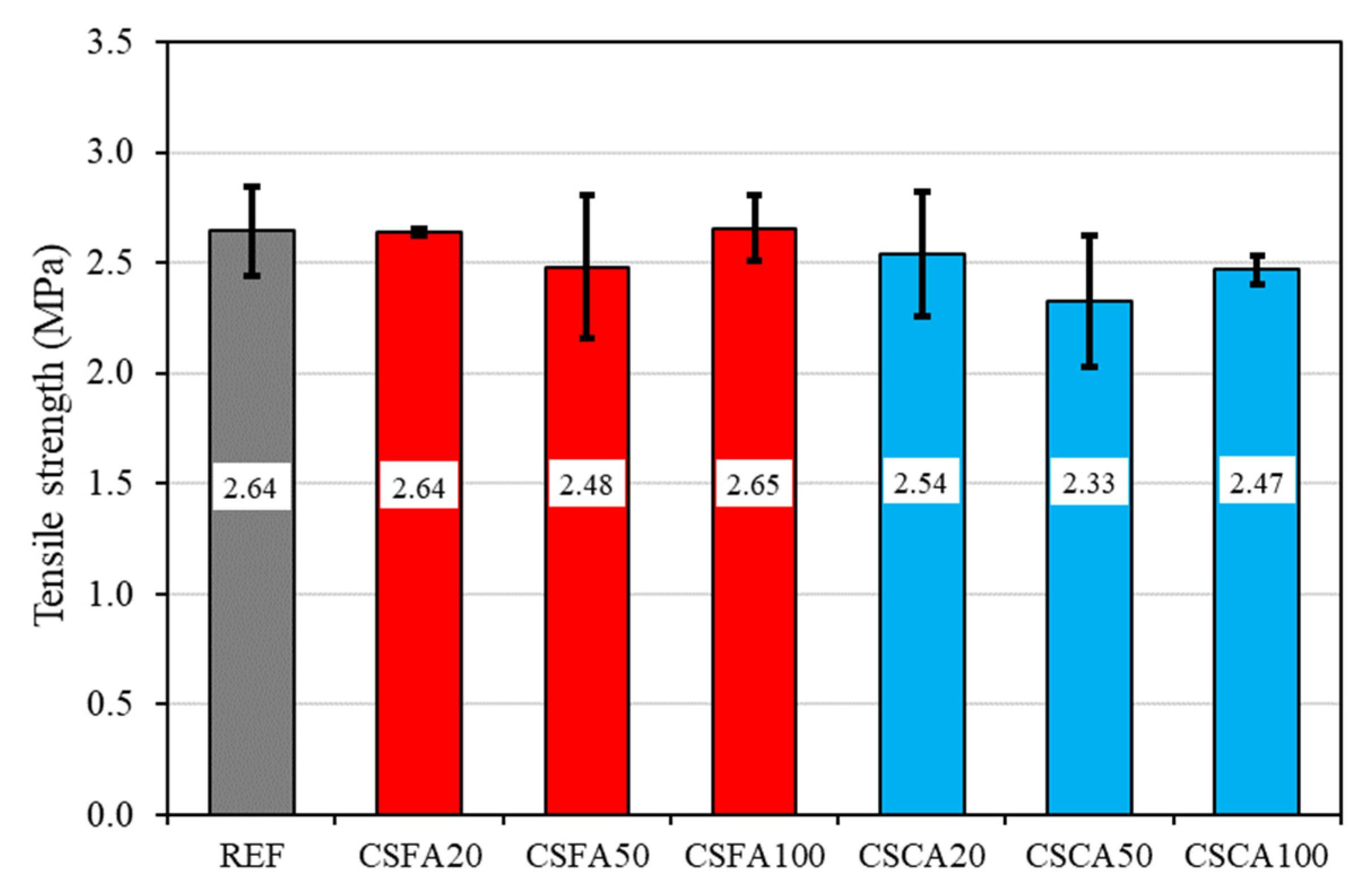
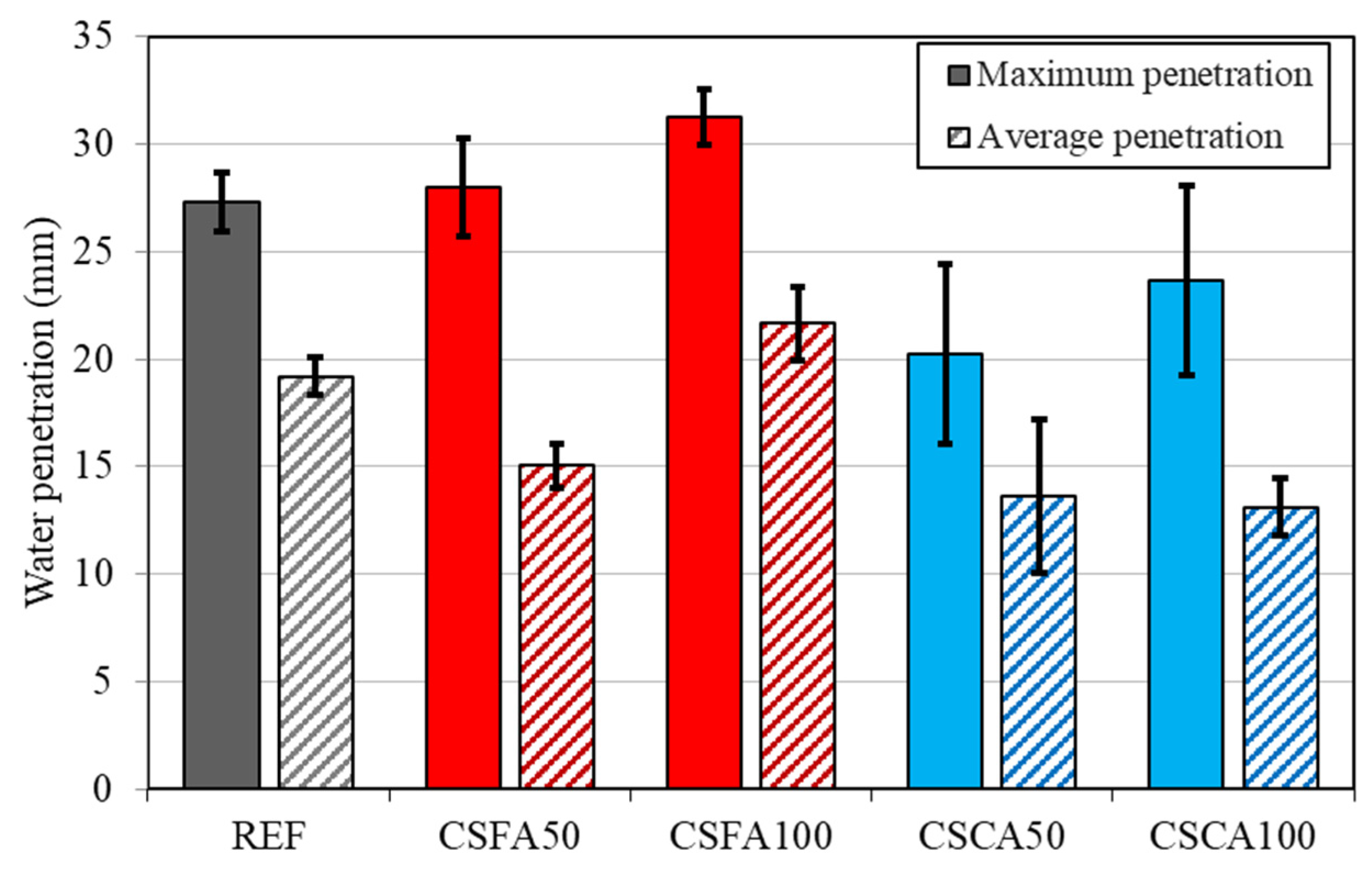
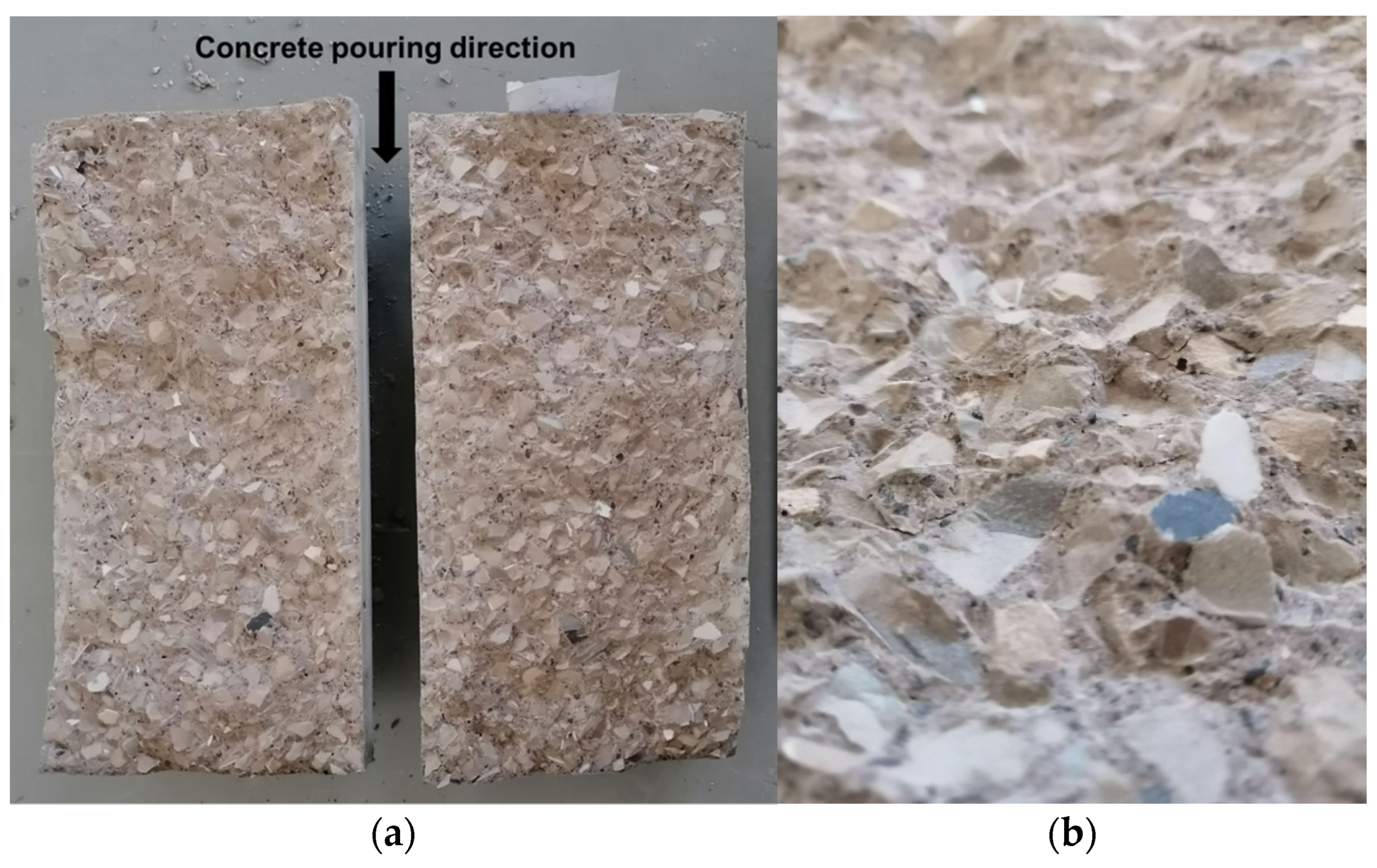
| Coarse Aggregates (4/12) | Fine Aggregates (0/4) | |||
|---|---|---|---|---|
| Natural (NCA) | Recycled (CSCA) | Natural (NFA) | Recycled (CSFA) | |
| Particle apparent density (kg/m3) | 2771.2 | 2373.7 | 2843.0 | 2423.3 |
| Water absorption, WA (wt.%) | 1.60 | 1.76 | 3.43 | 2.49 |
| Wear resistance (wt.%) | 24.05 | 3.76 | 28.75 | 17.20 |
| ID | Cement (kg) | Fine Aggregates | Coarse Aggregates | Water | Super- Plasticiser (kg) | ||||
|---|---|---|---|---|---|---|---|---|---|
| NFA (kg) Natural | CSFA (kg) Recycled | NCA (kg) Natural | CSCA (kg) Recycled | Effective Water (L) | Ratio w/c | Total Water (L) | |||
| Ref. | 425 | 651 | - | 1082 | - | 185 | 0.44 | 207.7 | 2.89 |
| CSFA20 | 520.8 | 110.9 | 1082 | - | 207.1 | ||||
| CSFA50 | 325.5 | 277.3 | 1082 | - | 206.2 | ||||
| CSFA100 | - | 554.6 | 1082 | - | 204.6 | ||||
| CSCA20 | 651 | - | 565.6 | 184.3 | 208.1 | ||||
| CSCA50 | 651 | - | 541.0 | 460.9 | 208.6 | ||||
| CSCA100 | 651 | - | - | 921.7 | 209.5 | ||||
Disclaimer/Publisher’s Note: The statements, opinions and data contained in all publications are solely those of the individual author(s) and contributor(s) and not of MDPI and/or the editor(s). MDPI and/or the editor(s) disclaim responsibility for any injury to people or property resulting from any ideas, methods, instructions or products referred to in the content. |
© 2023 by the authors. Licensee MDPI, Basel, Switzerland. This article is an open access article distributed under the terms and conditions of the Creative Commons Attribution (CC BY) license (https://creativecommons.org/licenses/by/4.0/).
Share and Cite
Roig-Flores, M.; Reig, L.; Albero, V.; Hernández-Figueirido, D.; Melchor-Eixea, A.; Pitarch, Á.M.; Piquer, A. Utilisation of Ceramic Stoneware Tile Waste as Recycled Aggregate in Concrete. Buildings 2023, 13, 1968. https://doi.org/10.3390/buildings13081968
Roig-Flores M, Reig L, Albero V, Hernández-Figueirido D, Melchor-Eixea A, Pitarch ÁM, Piquer A. Utilisation of Ceramic Stoneware Tile Waste as Recycled Aggregate in Concrete. Buildings. 2023; 13(8):1968. https://doi.org/10.3390/buildings13081968
Chicago/Turabian StyleRoig-Flores, Marta, Lucía Reig, Vicente Albero, David Hernández-Figueirido, Antonio Melchor-Eixea, Ángel M. Pitarch, and Ana Piquer. 2023. "Utilisation of Ceramic Stoneware Tile Waste as Recycled Aggregate in Concrete" Buildings 13, no. 8: 1968. https://doi.org/10.3390/buildings13081968
APA StyleRoig-Flores, M., Reig, L., Albero, V., Hernández-Figueirido, D., Melchor-Eixea, A., Pitarch, Á. M., & Piquer, A. (2023). Utilisation of Ceramic Stoneware Tile Waste as Recycled Aggregate in Concrete. Buildings, 13(8), 1968. https://doi.org/10.3390/buildings13081968










